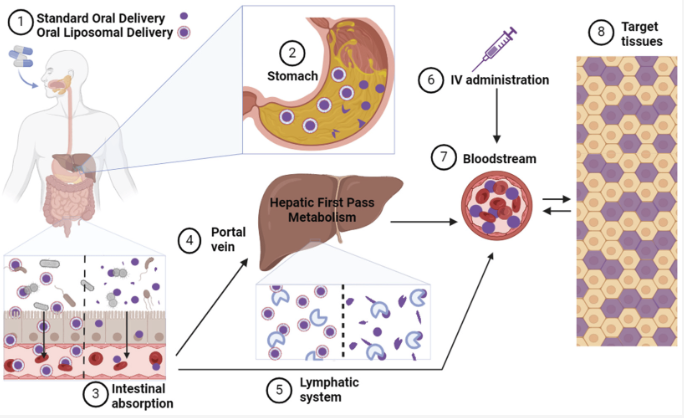This research reviews the current evidence on NMN metabolism and compares the effects of different administration routes.
Key Points
- NMN is broken down in the gut and liver to Nicotinamide (NAM) and Nicotinic Acid (NA)
- Injecting NMN (IV administration) avoids breakdown in gut and liver, offering different effects
- Liposomes protect NMN from gut and liver degradation, potentially delivering more to tissues
- The metabolism of NMN affects how it works in the body
Standard Oral NMN is Degraded By Gut Bacteria
A 2016 study found that NR supplemention increased a specific NAD+ metabolite that isn’t used in the normal human NAD+ pathways and interestingly, required a bacterial enzyme to be processed.
Later studies in mice confirmed that gut bacteria play a key role in NAD+ precursor metabolism, breaking down almost all NMN and NR into NAM or NA.
“Only a minor portion of NAD+ precursors delivered orally integrate into tissues without significant alteration.”
Any NMN that survives the GI tract is sent to the liver, where it is fully converted into NAM.
“Studies across various dosages (50 mg/kg to 500 mg/kg) consistently show that nearly all ingested NMN is converted into NAM within the liver.”
Essentially, no intact NMN from oral delivery reaches peripheral tissues.
“This minimizes the amount of intact NMN available for direct NAD+ synthesis in the liver and prevents it from reaching peripheral tissues, significantly impacting overall bioavailability.”
IV Administration Bypasses Metabolism in the Gut and Liver
When given by IV, NMN enters directly into the bloodstream, avoiding degradation in the gut and liver.
In mice, IV NMN allowed a small portion of intact NMN to contribute to NAD+ synthesis in the liver and kidneys.
“While incorporation of intact NMN was still limited, the observed differences highlight the crucial role of administration methods on NMN bioavailability.”
A human study showed that IV NMN (300 mg) was safe, increased NAD+ levels, and unexpectedly reduced triglyceride levels, demonstrating that the administration route affects NMN’s outcomes.
“A triglyceride-lowering effect has not been observed with oral NMN, indicating route-specific metabolic variations.”
Liposomal Delivery Mimics IV Administration Route
To improve delivery, compounds can be incorporated into liposomes—microscopic bubbles made from natural fats that resemble cell membranes.
These tiny shields protect NAD+ precursors from harsh stomach conditions and bacteria in the gut.
“The therapeutic agent is encapsulated and protected from degradation by enzymes and harsh conditions within the gastrointestinal tract.”
In the gut, liposomes interact with special cells, allowing them to enter the bloodstream directly and bypass degradation in the liver.
“Allowing entry into the lymphatic system and bypassing hepatic processing altogether.”
In an aging mouse model, oral administration of encapsulated NMN significantly reduced oxidative stress, improved behavioral performance, and increased NAD+ levels more effectively than free NMN.
This figure depicts the metabolic processing of common administration routes for NMN.

NMN Administration Routes and Metabolic Processing.
- Standard or liposomal NMN is ingested
- Standard capsules are broken down in stomach; liposomal formulations are protected from degradation
- Standard NMN is broken down by gut bacteria and enzymes; liposomal NMN is protected
- Standard NMN is transported to the liver and further broken down
- Liposomes exit the gut and enter the bloodstream, bypassing the liver
- Intravenous NMN directly enters bloodstream without undergoing processing in the intestine or liver
- Ultimately, NMN enters the bloodstream, but the amount reaching target tissues depends on the administration route and metabolic processing
Metabolism Affects Function
Although NAD+ metabolites share metabolic pathways, they have unique characteristics:
- NA: Lowers lipids levels, but causes a flushing side effect; leads to a faster, but smaller and shorter-lasting increase in NAD+ compared to NR
- NAM: Can inhibit sirtuins, while NMN and NR enhance sirtuin activity
- NMN: May be especially important for replenishing NAD+ levels during age-related decline
- NMN and NR: promote blood cell production (hematopoiesis), a benefit not seen with Niacin or Nicotinamide (NAM)
The breakdown products of these precursors might not have the same effects as the original compounds.
“NAD+ precursors display diverse fates and functions, suggesting they are not simply interchangeable building blocks for NAD+ synthesis.”
The complex metabolism and variable effects might explain why clinical trials on NAD+ boosters show mixed results.
“Okabe et al. observed increases in NAMN, a deamidated metabolite of NMN, alongside elevated NAD+.”
Systems that protect NMN from degradation and enable intact tissue delivery may clarify and enhance its therapeutic effects.
“The chosen administration route significantly impacts NMN’s fate.”
Conclusion
Regular NMN supplements are broken down in the gut and liver before reaching tissues.
IV NMN bypasses this breakdown and has different effects than oral supplementation.
Liposomal NMN is taken orally, but protected from breakdown, potentially delivering more NMN to the body.
The metabolism of NMN impacts its potential benefits, making the administration route crucial for understanding its therapeutic efficacy.
